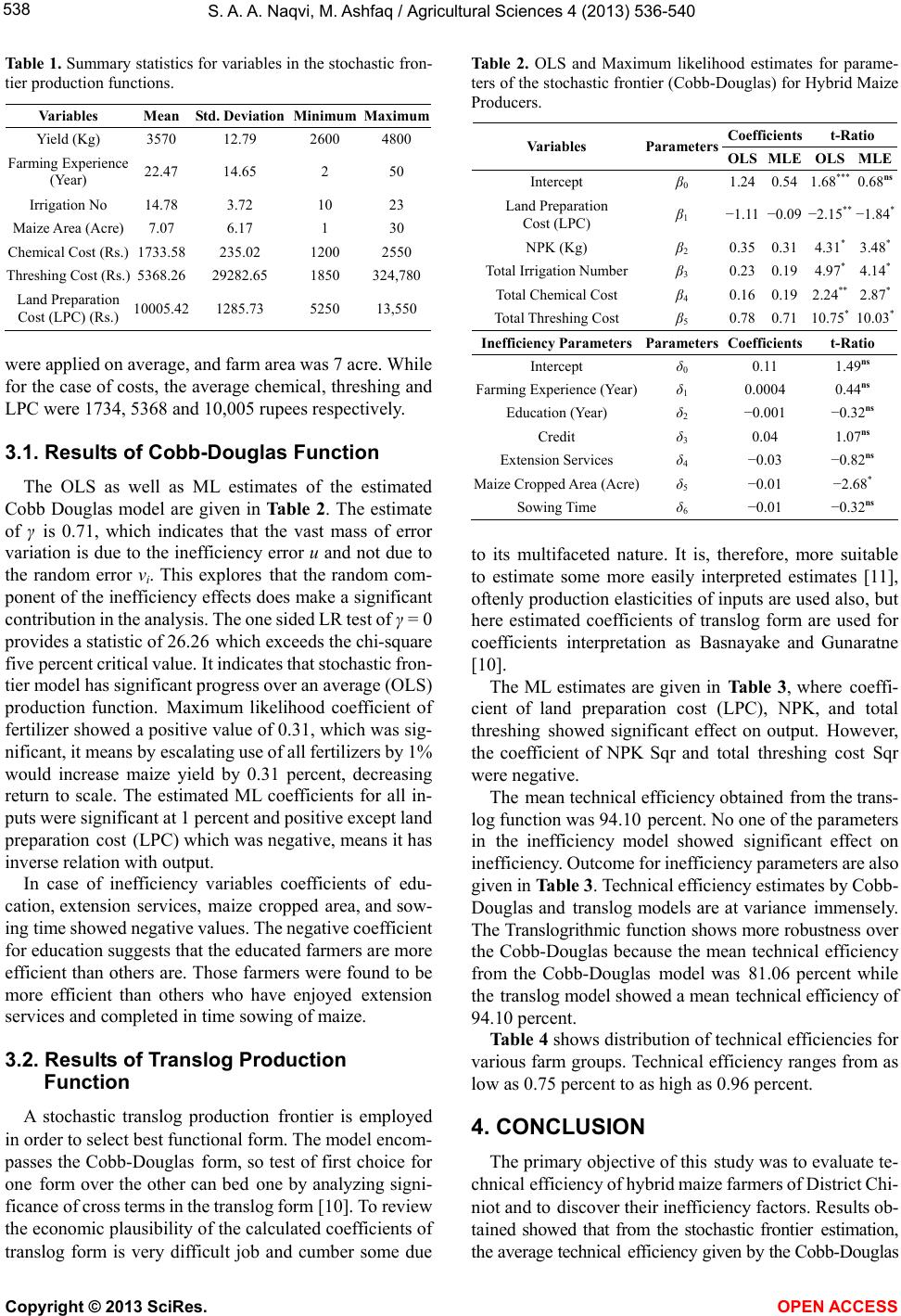
S. A. A. Naqvi, M. Ashfaq / Agricultural Sciences 4 (2013) 536-540
538
Tabl e 1 . Summary statistics for variables in the stochastic fron-
tier production functions.
Variables Mean Std. Deviation MinimumMaximum
Yield (Kg) 3570 12.79 2600 4800
Farming Experience
(Year) 22.47 14.65 2 50
Irrigation No 14.78 3.72 10 23
Maize Area (Acre) 7.07 6.17 1 30
Chemical Cost (Rs.) 1733.58 235.02 1200 2550
Threshing Cost (Rs.) 5368.26 29282.65 1850 324,780
Land Preparation
Cost (LPC) (Rs.) 10005.42 1285.73 5250 13,550
were applied on average, and farm area was 7 acre. While
for the case of costs, the average chemical, threshing and
LPC were 1734, 5368 and 10,005 rupees respectively.
3.1. Results of Cobb-Douglas Function
The OLS as well as ML estimates of the estimated
Cobb Douglas model are given in Ta bl e 2. The estimate
of γ is 0.71, which indicates that the vast mass of error
variation is due to the inefficiency error u and not due to
the random error vi. This explores that the random com-
ponent of the inefficiency effects does make a significant
contribution in the analysis. The one sided LR test of γ = 0
provides a statistic of 26.26 which exceeds the chi-square
five percent critical value. It indicates that stochastic fron-
tier model has significant progress over an average (OLS)
production function. Maximum likelihood coefficient of
fertilizer showed a positive value of 0.31, which was sig-
nificant, it means by escalating use of all fertilizers by 1%
would increase maize yield by 0.31 percent, decreasing
return to scale. The estimated ML coefficients for all in-
puts were significant at 1 percent and positive except land
preparation cost (LPC) which was negative, means it has
inverse relation with output.
In case of inefficiency variables coefficients of edu-
cation, extension services, maize cropped area, and sow-
ing time showed negative values. The negative coefficient
for education suggests that the educated farmers are more
efficient than others are. Those farmers were found to be
more efficient than others who have enjoyed extension
services and completed in time sowing of maize.
3.2. Results of Translog Production
Function
A stochastic translog production frontier is employed
in order to select best functional form. The model encom-
passes the Cobb-Douglas form, so test of first choice for
one form over the other can bed one by analyzing signi-
ficance of cross terms in the translog form [10]. To review
the economic plausibility of the calculated coefficients of
translog form is very difficult job and cumber some due
Table 2. OLS and Maximum likelihood estimates for parame-
ters of the stochastic frontier (Cobb-Douglas) for Hybrid Maize
Producers.
Coefficients t-Ratio
Variables Parameters
OLS MLE OLSMLE
Intercept β0 1.24 0.54 1.68*** 0.68ns
Land Preparation
Cost (LPC) β1 −1.11 −0.09 −2.15** −1.84*
NPK (Kg) β2 0.35 0.31 4.31*3.48*
Total Irrigation Numberβ3 0.23 0.19 4.97*4.14*
Total Chemical Cost β4 0.16 0.19 2.24** 2.87*
Total Threshing Cost β5 0.78 0.71 10.75*10.03*
Inefficiency ParametersParameters Coefficients t-Ratio
Intercept δ0 0.11 1.49ns
Farming Experience (Year)δ1 0.0004 0.44ns
Education (Year) δ2 −0.001 −0.32ns
Credit δ3 0.04 1.07ns
Extension Services δ4 −0.03 −0.82ns
Maize Cropped Area (Acre)δ5 −0.01 −2.68*
Sowing Time δ6 −0.01 −0.32ns
to its multifaceted nature. It is, therefore, more suitable
to estimate some more easily interpreted estimates [11],
oftenly production elasticities of inputs are used also, but
here estimated coefficients of translog form are used for
coefficients interpretation as Basnayake and Gunaratne
[10].
The ML estimates are given in Ta b l e 3 , where coeffi-
cient of land preparation cost (LPC), NPK, and total
threshing showed significant effect on output. However,
the coefficient of NPK Sqr and total threshing cost Sqr
were negative.
The mean technical efficiency obtained from the trans-
log function was 94.10 percent. No one of the parameters
in the inefficiency model showed significant effect on
inefficiency. Outcome for inefficiency parameters are also
given in Table 3. Technical efficiency estimates by Cobb-
Douglas and translog models are at variance immensely.
The Translogrithmic function shows more robustness over
the Cobb-Douglas because the mean technical efficiency
from the Cobb-Douglas model was 81.06 percent while
the translog model showed a mean technical efficiency of
94.10 percent.
Tab le 4 shows distribution of technical efficiencies for
various farm groups. Technical efficiency ranges from as
low as 0.75 percent to as high as 0.96 percent.
4. CONCLUSION
The primary objective of this study was to evaluate te-
chnical efficiency of hybrid maize farmers of District Chi-
niot and to discover their inefficiency factors. Results ob-
tained showed that from the stochastic frontier estimation,
the average technical efficiency given by the Cobb-Douglas
Copyright © 2013 SciRes. OPEN A CCES S